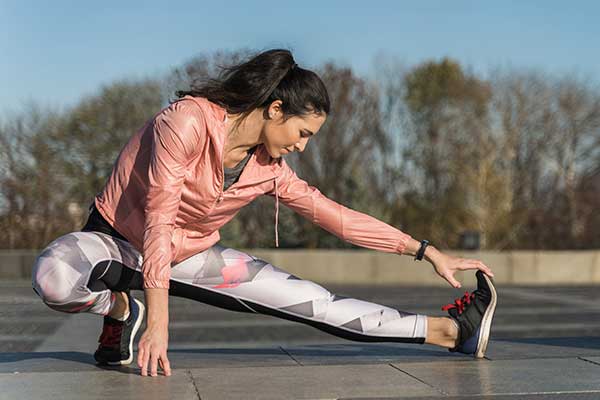Best Neck Stretching Exercises for a Stiff Neck
Are you feeling a persistent tightness in your neck? Stiff necks can be more than just an annoyance; they can disrupt your daily activities and leave you searching for relief. Whether it’s from long hours at a desk, poor posture, or even stress, many people experience this discomfort. But there’s good news! Incorporating simple stretching exercises into your routine can help alleviate tension and improve flexibility. If you’re on the hunt for the best neck stretching exercises for a stiff neck, you’ve come to the right place. Let’s dive into what causes that nagging stiffness and how targeted stretches can make all the difference in restoring comfort to your day-to-day life.
What Causes a Stiff Neck?
A stiff neck can arise from various factors, and understanding these causes is key to effective relief. One common culprit is poor posture, especially during long hours of sitting or staring at screens. When your head juts forward, it puts extra strain on your neck muscles.
Muscle strains are another frequent cause. Sudden movements or sleeping in an awkward position can lead to tightness and discomfort. Even everyday activities like lifting heavy objects improperly can contribute.
Stress plays a significant role as well. Tension often accumulates in the neck area when you’re under pressure, leading to stiffness over time.
In some cases, underlying medical conditions such as arthritis or herniated discs can also be responsible for persistent neck pain. Recognizing these triggers will help you address the issue more effectively and find suitable stretches for relief.
Benefits of Regularly Stretching Your Neck
Regularly stretching your neck can lead to significant improvements in your overall well-being. It helps alleviate tension and reduces discomfort caused by long hours of sitting or poor posture.
Increased flexibility is another advantage, allowing for a greater range of motion. This can enhance daily activities, making movements smoother and more effortless.
Stretching also promotes better circulation in the neck area. Improved blood flow encourages faster recovery from strain and may even relieve headaches related to muscle tightness.
Moreover, dedicating time to stretch can contribute to stress relief. The act itself offers a moment of mindfulness, helping you unwind amid a busy day.
Incorporating these exercises into your routine fosters awareness of body alignment, encouraging healthier habits over time.
Top 5 Neck Stretching Exercises:
Chin tucks are a simple yet effective way to strengthen the muscles in your neck. Start by sitting or standing tall, gently drawing your chin toward your chest. Hold for a few seconds, and feel the stretch along the back of your neck.
Next up is side-to-side head rotation. Sit upright and slowly turn your head to one side until you feel a gentle pull. Hold for a moment, then switch sides. This exercise helps improve flexibility and range of motion.
Shoulder rolls can relieve tension quickly. Roll your shoulders forward in a circular motion several times, then reverse direction. It loosens tightness not just in the neck but also across the upper back.
For an ear-to-shoulder stretch, tilt your head sideways toward one shoulder while keeping the opposite shoulder down. You should feel this stretch along the side of your neck.
Try neck rotation with arm extension. Extend one arm out at shoulder height while rotating your head towards that hand. This enhances both strength and stability in the area.
A. Chin Tucks
Chin tucks are a simple yet effective exercise for alleviating neck stiffness. This movement helps strengthen the muscles that support your head and neck alignment.
To perform a chin tuck, sit or stand up straight. Gently pull your chin back towards your throat. Imagine creating a double chin without tilting your head down or lifting it up.
Hold this position for five seconds while breathing deeply. Release and repeat several times throughout the day.
This exercise can be done anywhere—at work, home, or even during your commute! Regular practice can help improve posture and reduce tension in the neck area over time.
Remember to keep movements slow and controlled to avoid strain. Consistency is key; try incorporating chin tucks into your daily routine for optimal results.
B. Side-to-Side Head Rotation
Side-to-side head rotation is an effective way to enhance neck mobility. This simple exercise can help alleviate stiffness and improve your range of motion.
To perform this stretch, sit or stand comfortably with your back straight. Slowly turn your head to the right until you feel a gentle stretch in the muscles on the opposite side of your neck. Hold for a few seconds, then return to center.
Next, repeat the movement on the left side. Remember to keep it slow and controlled; rushing can lead to strain.
Aim for 5–10 repetitions on each side, breathing deeply throughout. This helps release tension accumulated from daily activities like sitting at a desk or looking down at your phone.
Incorporating this exercise into your routine could bring significant relief and flexibility over time.
C. Shoulder Rolls
Shoulder rolls are a simple yet effective way to relieve tension in your neck and shoulders. This exercise not only improves flexibility but also helps increase blood circulation in the upper body.
To perform shoulder rolls, start by sitting or standing up straight. Relax your arms at your sides. Gently lift both shoulders towards your ears, then roll them back and down in a smooth motion.
Repeat this movement for about 10 repetitions, feeling each muscle release as you go. Afterward, switch directions—roll forward this time—to balance the stretch across all areas of your shoulders.
Incorporating shoulder rolls into your daily routine can dramatically reduce stiffness. These gentle movements are perfect for breaks during work hours or as part of a warm-up before more intense exercises.
D. Ear to Shoulder Stretch
The Ear to Shoulder Stretch is a simple yet effective exercise for relieving neck tension. Begin by sitting or standing comfortably, ensuring your posture is upright.
Gently tilt your head towards one shoulder. Aim to bring your ear closer without lifting the opposite shoulder. This movement creates a delightful stretch along the side of your neck.
Hold this position for about 15-30 seconds, feeling the gentle pull in the muscles. Breathe deeply as you maintain that stretch; it helps enhance relaxation and increases blood flow.
Switch sides and repeat, allowing both sides of your neck to benefit equally from this exercise. It’s an excellent way to combat stiffness brought on by long hours at a desk or looking down at screens.
Incorporating the Ear to Shoulder Stretch into your routine can lead to significant improvements in flexibility and comfort throughout your day.
E. Neck Rotation with Arm Extension
Neck rotation with arm extension is an effective stretch that targets both your neck and shoulders. This dynamic movement promotes flexibility and alleviates tightness.
Start by sitting or standing tall. Extend one arm straight out to the side at shoulder height. As you do this, gently rotate your head toward the extended arm. Hold for a few seconds, feeling the gentle stretch along your neck.
Next, switch arms and repeat the process on the other side. This exercise encourages blood flow while enhancing range of motion.
Be mindful of your posture throughout this stretch. Ensure that you’re not straining but instead moving within a comfortable range. With consistent practice, you’ll likely notice improved mobility in your neck area over time.
Tips for Proper Technique and Safety
When performing neck stretches, proper technique is key to avoiding injury. Start slowly and listen to your body. If you feel any sharp pain, stop immediately.
Maintain good posture during each stretch. Keep your back straight and shoulders relaxed. This alignment helps target the right muscles while preventing strain.
Breathe deeply throughout your routine. Inhale as you prepare for a stretch and exhale as you move into it. Controlled breathing can enhance relaxation and improve flexibility.
Consider warming up with light activity before stretching. A few minutes of gentle movements can increase blood flow to the area, making it easier to perform exercises safely.
Additionally, never force a movement beyond your comfort zone. Gradual progress is more beneficial than pushing too hard too fast. Regularly assess how you’re feeling; adjustments may be necessary based on daily conditions or activities.
Precautions and When to Seek Medical Help
When engaging in neck stretching exercises, it’s crucial to listen to your body. Any sharp or persistent pain is a signal to stop immediately. Stretching should always feel relieving rather than painful.
Avoid pushing yourself too hard. If you experience dizziness, numbness, or weakness in your arms and hands while stretching, cease the activity right away. These could indicate more serious issues that require attention.
If stiffness persists for several days despite regular stretching or worsens over time, it may be time to consult a healthcare professional. An expert can diagnose potential underlying conditions such as herniated discs or pinched nerves.
Additionally, if you’ve recently experienced trauma or injury to the neck area, seek medical advice promptly. Protecting your overall health is paramount when dealing with any discomfort in this sensitive region of the body.
Conclusion
A stiff neck can be a real inconvenience, affecting your daily activities and overall comfort. Incorporating the best neck stretching exercises into your routine can help alleviate tension and improve flexibility. Regularly dedicating time to stretch your neck not only eases discomfort but also helps prevent future stiffness.
By practicing exercises like chin tucks, side-to-side head rotations, shoulder rolls, ear-to-shoulder stretches, and neck rotation with arm extension, you can create a stronger foundation for better posture and movement. Remember that proper technique is essential. Be gentle with yourself as you perform these stretches.
Safety should always come first; if any exercise causes pain or discomfort beyond mild stretching sensations, stop immediately. If the stiffness persists despite regular stretching or worsens over time, seeking medical advice may be necessary to rule out underlying issues.
Making these simple yet effective neck stretches part of your day could lead to significant improvements in mobility and comfort levels. Embrace a healthier lifestyle by caring for one of the most vital parts of our body—the neck!
- About the Author
- Latest Posts
Johnnie D. Jackow Sr., the founder and CEO of Total Body Fitness, Worldwide, has a long-standing career in the fitness industry. He began as a certified personal trainer in the mid-90s and soon after authored his first weight loss book in 1998. This led to the launch of Total Body Fitness, Nationwide in the USA at the same time. Johnnie gained recognition as the fitness guru of his time, running infomercials on local TV late at night in Houston, Texas. Over the years, he has helped more than 40,000 individuals from all over the world achieve their health and fitness goals. With over 60,000 hours of documented training in integrative functional medicine, he completed his PhD in human physiology in 2010. His primary objective is to assist people in reaching their health and fitness goals through alternative approaches rather than relying solely on conventional medicine and pharmaceutical drugs. Today, with almost three decades of experience under his belt, Johnnie continues to be a leader in health and fitness.








